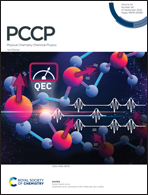A theoretical insight into excited-state decay and proton transfer of p-nitrophenylphenol in the gas phase and methanol solution†
Abstract
The excited-state decay (ESD) and proton transfer (EPT) of p-nitrophenylphenol (NO2-Bp-OH), especially in the triplet states, were not characterized with high-level theoretical methods to date. Herein, the MS-CASPT2//CASSCF and QM(MS-CASPT2//CASSCF)/MM methods were employed to gain an atomic-level understanding of the ESD and EPT of NO2-Bp-OH in the gas phase and its hydrogen-bonded complex in methanol. Our calculation results revealed that the S1 and S2 states of NO2-Bp-OH are of 1ππ* and 1nπ* characters at the Franck–Condon (FC) point, which correspond to the ICT-EPT and intramolecular charge-transfer (ICT) states in spectroscopic experiments. The former state has a charge-transfer property that could facilitate the EPT reaction, while the latter one might be unfavorable for EPT. The vertical excitation energies of these states are almost degenerate at the FC region and the electronic configurations of 1ππ* and 1nπ* will exchange from the S1 FC region to the S1 minimum, which means that the 1nπ* state will participate in ESD once NO2-Bp-OH departs from the S1 FC region. Besides, we found that three triplets lie below the first bright state and will play very important roles in intersystem crossing processes. In terms of several pivotal surface crossings and relevant linearly interpolated internal coordinate (LIIC) paths, three feasible but competing ESD channels that could effectively lead the system to the ground state or the lowest triplet state were put forward. Once arrived at the T1 state, the system has enough time and internal energy to undergo the EPT reaction. The methanol solvent has a certain effect on the relative energies and spin–orbit couplings, but does not qualitatively change the ESD processes of NO2-Bp-OH. By contrast, the solvent effects will remarkably stabilize the proton-transferred product by the hydrogen bond networks and assist to form the triplet anion. Our present work would pave the road to properly understand the mechanistic photochemistry of similar hydroxyaromatic compounds.



 Please wait while we load your content...
Please wait while we load your content...